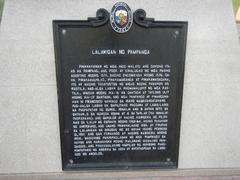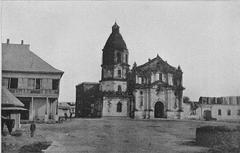
Comprehensive Guide to Visiting Bacolor, Pampanga, Philippines
Date: 13/08/2024
Captivating Introduction
Imagine a place where history, culture, and resilience blend seamlessly into one captivating narrative. Welcome to Bacolor, Pampanga—a town that has not just survived but thrived through the vicissitudes of time. Located in the heart of the Philippines, Bacolor’s story is a vivid tapestry woven with threads of early Malay settlement, Spanish colonial grandeur, American influence, and the indomitable spirit that emerged unscathed from the catastrophic eruption of Mount Pinatubo. This guide will take you through Bacolor’s rich historical landscapes, its iconic landmarks, and its vibrant cultural life, offering you a journey that is as educational as it is inspiring. So, pack your bags and let’s embark on a journey through time and culture in Bacolor. (Bacolor Pampanga, Nomadic Experiences)
Table of Contents
- Introduction
- Historical Significance
- Key Attractions
- Local Cuisine
- Festivals and Events
- Visitor Tips
- Nearby Adventures
- Conclusion
- Sources
Discover Bacolor, Pampanga: A Journey Through Resilience and Heritage
The Beginning: Early Settlement and Spanish Colonial Era
Imagine stepping into a town so rich in history that its roots trace back to the same year Manila was founded—1571. Welcome to Bacolor, a high-level rocky place aptly named ‘Bakúlud’ by its early Malay settlers from Sumatra. Picture this: a bustling settlement led by Panday Pira, and later officially established in 1574 by landlord Guillermo Manabat. His grand home now stands as the site of the iconic San Guillermo Church. (Bacolor Pampanga)
By 1698, Bacolor had blossomed into the first capital of Pampanga, a title it held for over two centuries. The provincial building, Casa Real, constructed in 1757, still echoes stories of yesteryears from where the Bacolor Elementary School now stands. In a dramatic twist of fate, Governor General Simon de Anda made Bacolor the seat of the Spanish Government during the British invasion of Manila in 1762, marking it as the de facto capital of the Philippines. (Inquirer)
Winds of Change: American Invasion and Post-Colonial Period
Fast forward to the American colonization, where Bacolor continued to evolve. Although it lost its status as the provincial capital to San Fernando in 1904, its spirit remained unbroken. Imagine Commissioner William H. Taft inaugurating the civil government at the old Escuela de Artes y Oficios de Bacólor, now the esteemed Don Honorio Ventura State University. (Bacolor Pampanga)
The Eruption of Mount Pinatubo: A Test of Resilience
The air was thick with ash, and the sky darkened on June 15, 1991, when Mount Pinatubo erupted. Bacolor was buried under 20 feet of volcanic debris, but from this catastrophe arose a tale of resilience. Eighteen out of its 21 barangays were buried, yet Bacolor, now elevated to approximately 37 meters above sea level, began to rebuild and reclaim its heritage. (Wikipedia)
Landmarks: Echoes of the Past
San Guillermo Parish Church
Imagine walking into a half-buried church that stands as a testament to Bacolor’s indomitable spirit. Built in 1576 and reconstructed in 1897, the San Guillermo Parish Church features stunning Baroque and Rococo architecture. Despite being half-buried by lahar, it still serves as a place of worship and a symbol of resilience. (Nomadic Experiences)
Museo de Bacolor
Adjacent to the church, the Museo de Bacolor offers a treasure trove of artifacts, photos, and memorabilia. It’s like stepping into a time machine that whisks you through Bacolor’s pre- and post-eruption days, celebrating its enduring spirit. (Bacolor Pampanga)
Simon de Anda Monument
Nestled within the town hall grounds, the Simon de Anda Monument honors the man who made Bacolor the provincial capital during the British invasion. This monument is a nod to Bacolor’s strategic importance in Philippine history. (Bacolor Pampanga)
Notable Figures: Pride of Bacolor
Bacolor is the proud hometown of several illustrious figures, including the first governor of Pampanga, Tiburcio Hilario, and prominent jurists like Justices Roberto Regala and Eduardo Gutierrez David. Former Justice Minister and Solicitor General Estelito Mendoza and revolutionary general turned senator, Francisco Liongson, also hail from here. (Inquirer)
Key Attractions in Bacolor, Pampanga, Philippines
San Guillermo Parish Church
Imagine a church so determined to stand tall that it defied a volcano! The San Guillermo Parish Church, affectionately known as the Sunken Church, is Bacolor’s pride and joy. Built in 1576, this Spanish Colonial-era church was buried halfway by the Mount Pinatubo eruption in 1991. Yet, it wasn’t abandoned. The resilient townsfolk dug it out, preserving its baroque beauty and making it a living monument to their indomitable spirit. Today, you can wander through its half-buried halls and feel the palpable sense of survival and faith (Nomadic Experiences).
Museo de Bacolor
Right next door to the San Guillermo Parish Church is the Museo de Bacolor, a treasure trove of the town’s history. Housed in what was once the church’s convent, this museum showcases religious icons, historical artifacts, and photographs that tell the tale of Bacolor before and after the Mount Pinatubo eruption. It’s a vivid journey through time, offering insights into the resilience and cultural heritage of Bacolor (Nomadic Experiences).
Don Honorio Ventura State University
Established in 1861, Don Honorio Ventura State University (DHVSU) is an educational gem. It’s one of the oldest institutions in the Philippines, blending historical architecture with modern facilities. A stroll through its picturesque campus is not just a walk through a place of learning but a journey through time, reflecting Bacolor’s commitment to education and progress.
Bacolor Town Plaza
If you want to feel the heartbeat of Bacolor, head to the Bacolor Town Plaza. This vibrant hub is surrounded by historical buildings and features a monument dedicated to the town’s heroes. It’s a lively spot where locals gather for festivals, public events, or simply to enjoy a lazy afternoon. Take a leisurely stroll and immerse yourself in the daily life of Bacolor residents.
Betis Church
While not in Bacolor, the Betis Church in nearby Guagua is a must-see. Known as the “Sistine Chapel of the Philippines,” its stunning ceiling murals and intricate woodwork will leave you in awe. This National Cultural Treasure is a showcase of Pampanga’s rich artistic heritage and just a short trip from Bacolor (Taralets Anywhere).
Local Cuisine
Bacolor is a food lover’s paradise, offering a mouth-watering array of local delicacies. Don’t miss:
- Sisig: A tantalizing mix of pig head and liver, spiced with calamansi, onions, and chili peppers.
- Bringhe: Bacolor’s take on paella, made with glutinous rice, coconut milk, and a variety of meats and veggies.
- Tocino: Sweet cured pork that’s a breakfast favorite.
- Buro: Fermented rice with fish or shrimp, a unique local condiment.
For the best bites, check out local eateries like Aling Lucing’s Sisig and Everybody’s Café (Taralets Anywhere).
Festivals and Events
Bacolor knows how to throw a party! The Fiesta de San Guillermo honors the town’s patron saint with religious processions, cultural performances, and community activities. The Sinukwan Festival celebrates the Kapampangan spirit with vibrant street dances, parades, and traditional music. Join in and experience the town’s festive spirit firsthand.
Visitor Tips
- Best Time to Visit: November to April is ideal, avoiding the rainy season’s lahar flows. Plan your trip during festivals for an extra dose of culture.
- Getting There: Bacolor is a two-hour drive from Manila. Buses and jeepneys are available, or opt for a private car rental for comfort.
- Stay: Accommodation options in Bacolor are limited, but nearby Angeles and San Fernando offer plenty of choices.
- Etiquette: Dress modestly at religious sites like the San Guillermo Parish Church. A polite greeting and a smile go a long way with locals.
Nearby Adventures
- Mount Pinatubo: Trek to the crater of Mount Pinatubo for stunning views. Guided tours usually include a 4x4 ride and a hike to the crater lake.
- Sandbox: For thrill-seekers, Sandbox in Porac offers ATV rides, wall climbing, and zip-lining (Taralets Anywhere).
- Nayong Pilipino: This cultural theme park in Clark Freeport Zone features replicas of famous Philippine landmarks and traditional villages (Taralets Anywhere).
Conclusion
Bacolor is not just a destination; it’s a testament to the resilience and rich cultural heritage of the Philippines. From the awe-inspiring San Guillermo Parish Church, half-buried yet standing tall, to the vibrant Bacolor Town Plaza, each corner of this town tells a story of survival, faith, and community. Whether it’s savoring local delicacies like sisig and bringhe or losing yourself in the historical exhibits at the Museo de Bacolor, this journey through Bacolor offers a unique blend of past and present. As you leave this remarkable town, you’ll carry with you not just memories but a sense of awe for its enduring spirit. Make sure to download the Audiala app to uncover even more hidden gems and stories that make Bacolor a must-visit destination. (Bacolor Pampanga, Nomadic Experiences)
Sources
- Bacolor Pampanga. History of Bacolor. Bacolor Pampanga
- Nomadic Experiences. Buried but not quite by Mt. Pinatubo’s. Nomadic Experiences
- Taralets Anywhere. Best Pampanga Tourist Spots. Taralets Anywhere
- Inquirer. Pampanga town that survived Mt. Pinatubo reclaims Spanish name and seal. Inquirer



